New section for my geological journey. I sat down the beach one night looking at the cliffs and suddenly realised I knew very little about geological history, so I’ve made an effort and learn about geological periods and rock types and figure out the story. And what a great place to learn from…

Quick links to sections: Fossils at Goodrington, Triangle Point, Fossils at Broadsands, Saltern Cove, Devonshire Marbles, Cleaning & Polishing Pebbles.
Torbay; or the English Riviera GeoPark, precedes the famous Jurassic Coast, younging eastward along the Devon and Dorset coastline. Generally speaking; you get a succession of rock from the older Devonian (400mya) at Start Point, through the Permian, Triassic, Jurassic, to the more recent Cretaceous (100mya) chalk of the Isle Of Wight. 300 million years of Earths history in 100 miles of cliffs, and fossils starting with early complex life in the oceans; through the colonisation of the land; to the age of dinosaurs and beyond.
The cliffs and the rocks and pebbles we see at each beach are all different, almost all sedimentary rock like limestone; shale; sandstone etc (with very occasional volcanic intrusions), sediments from a large variety of different depositional environments and conditions. The whole ancient land mass of SW England is today tilted a few degrees clockwise if looking from the sea, so at sea-level it conveniently exposes the millions of years of rock layers from West to East; older to younger, like pages of chronological history along the coast.
The Torbay area is Devonian and Permian age rocks so late-Palaeozoic (ancient-life), Exmouth to Portland is Mesozoic (middle-life). I describe this area as pre-Jurassic coast.
Visible in headlands of Berry Head and Hopes Nose, and the many quarries with their distinctive grey cliffs and often accompanied by old lime kilns is the Devonian limestone, biogenous rock made of the tiny skeletons of marine micro-organisms which gradually settled on the seafloor when the area was sub-tropical just south of the equator around 400mya. The red Permian sandstone cliffs and headlands are from a desert environment as the continent had drifted north sitting on the equator from 300mya.
My beach; Broadsands, has Churston Group limestone at the south end, and a more mixed and faulted situation at the north with sections of Devonian limestones and mudstones, Permian sandstone/breccia, lots of crystalline calcite, and a tall flat grey cliff of Meadfoot Group limestone, the whole cliff line is a large fault with many interesting features.
Iron oxide from the red rocks stains a lot of the otherwise blue-grey limestone to a pinkish colour, and some of the otherwise creamy translucent calcite has red staining. The pebbles on the beach are mainly limestone, but the north rip-rap area traps a diverse range of rocks; I have collected lots of interesting things up there; many yet to be identified – I’ll create a section for that stuff sometime.

So, I’m doing pretty well surveying my local area and explaining some things. But theres something missing: the Carboniferous?! This 60 million year long geological period sits between the Devonian and Permian. Was there no sediments laid down, or did that rock get erased from the rock record?!
This, and another problem, come together…
The iconic tors of Dartmoor might be considered similar to the tors of Torbay, but they are totally different things. Dotted along the spine of the Westcountry are a series of granite outcrops, from Lands End to Bodmin to Dartmoor, each are granite ‘mountains’ and though only reaching 600 meters these peeks dominate the landscape.
Granite is a rock that can only form deep underground; like when two continents crash into each other creating pressure and uplift forming mountains; some kilometres beneath those mountains the hot magma in the mantle rises in areas known as a pluton. When the pressure is relieved and the mountain building ceases, the chamber of magma gradually cools; slowly enough that the minerals can grow large crystals; large enough to see, all tightly packed together, eventually solidifying into the very hard crystalline intrusive igneous rock we call granite.
So, granite forms deep underground; like maybe 5km or more, and today the granite tors are the highest points around; hundreds of meters above the coast… And the granites of the moors date to… the Carboniferous! So… how, why, what?!
Understanding this story is difficult, and involves real comprehension of ‘deep time’. And my attempt at interpretation here is very much a work in progress!
One of our special local sites is the visible unconformity on the beach at Oyster Cove where the rock record has that 100 million year gap in it, Devonian age mudstone below; and then on top at a different angle is Permian age sandstone. Another clue is that the granite plutons of Dartmoor are Carboniferous age; and these must have formed underground while the whole area was being compressed into a high mountain range, being exposed to the elements including glaciers; it was sanded down and the Carboniferous rock layers were eroded and transported away down river systems.
For the locality of the unconformity; the erosion stopped at the Devonian mudstone which was left exposed as the new ‘top’ of the rock record. Somewhere along the line this Devonian rock unit had been tilted a bit so the layers were no longer horizontal; and the next time sediments were laid on top (horizontally) was in desert conditions in the Permian. Today the top-most rock unit is that Permian breccia; any subsequent younger rock layers also having eroded away, and the two-layer cake visible as a small cliff on the beach leans towards the sea. I’ll get a photo of this textbook example of an unconformity sometime soon, and try to get a better understanding of it.
Our lovely beach sand comes from the erosion of the red sandstone cliffs back into individual sand grains again, recycling the desert sands buried 270mya ago. That sand in the Permian sandstone will have come from the weathering of igneous rock sometime before that. The sand on the beach today may again become buried and compacted and become a sandstone, again…

So a grain of sand may have a long story to tell, being primarily quartz grains; the toughest longest-surviving mineral grains gradually reduced in size and polished and rounded like sea glass. Broadsands sand also has a lot of broken shell material, and also the black material here is decomposing seaweed and other organic remains.
Anyway… I have a foundation in the science now, but like one teacher said: “Geology only comes with experience.” So its all about learning for myself, visiting local sites and exploring the area, picking up a lot of rocks along the way; and doing some photography to help me document the journey.
The first fossils I ever saw, found by accident, hundreds in one rock.
The north end of Broadsands has the sea defence wall and a big area of ‘rip-rap’ rock-armour boulders; as well as a massive chunk of the red cliff departed and sitting just down the beach. In and around all of this is a pebble beach with all kinds of things washed up; human stuff and a real mixture of rocks and all sorts, a great place to explore.

I’d been visiting and picking up interesting rocks up here for a while, I discovered and learned about calcite crystals, chert nodules, and had collected a load of other cool rocks which I couldn’t explain.. but then one day I noticed one of the rip-rap boulders itself was covered in little shapes; which could only be one thing: life! But not as we know it, Jim…
Since then I’ve surveyed most of the boulders and found about 6 which clearly fit the description of ‘rice rock’, for fairly self-explanatory reasons. The best rice-rock boulder I’ve found is one of the first you come to; if you walk around the back by the wall; it is one of those on your right.
Biological tissues rarely fossilise, so the shapes which leave a trace are skeletons; shells; or structures created by the lifeforms, for sponges this is a silica skeleton, for corals its the colonial or solitary carbonate structures which polyps live within, for bivalves it is the shells.



These boulders are teeming with life; almost every shape you see is a fossil. I think the many ‘rice grains’ in rice-rock are algal colonies; large numbers appearing lined up almost like shoals in a current. Then there are cross sections of various corals, bryozoans, stromatoporoid sponges, calcareous algal mats etc, but I can’t identify things very well yet!
Torbay is surrounded by limestone; but only certain lucky layers and locations contain this highly fossilicious rock, including some incredibly well preserved insights into ancient Devonian reefs. These boulders must have been taken from quarries fairly nearby; don’t know which yet.

The significance of these for me is that these fossils are 400 million years old, four hundred million years!! Thats almost a different planet back then, most of the species found here are long extinct; and these collections of fossils are images of eco-systems from a time when life was just getting started on the land.
In astronomical terms; the most distant objects I’ve seen in my telescope are a few incredibly dim galaxies in the Virgo Cluster at 60 million light years away, thats about the same time as the ‘end of the dinosaurs’ extinction 65 million years ago. You need a very big telescope to see galaxies 400mly away! And half a billion years; is one ninth of the very existence of the planet Earth…
South Sands, Goodrington – fossils in the pebbles
For years I didn’t think there were any fossils on our beaches, or nothing much to see, but I was wrong! After reading about fossils on the OUGS web page here, I went for a look and was quite amazed by how many rice-rock type pebbles there are at Goodrington. Some are messy and hard to see any detail; but occasionally you find some real gems!
The place of most abundance that I’ve found so far is at South Sands on the wet pebble banks by the water outlet pipe; the part of the beach you see pictured here:

Many of these grey limestone pebbles have curious shapes in them; and some patience searching can yield some really detailed fossils of corals and other reef life. Most visible when wet; and the clearest details are seen on the smooth surfaces of well-tumbled pebbles. These are cross-sectional images of 3D shapes preserved within the rock; quite often the same lifeform is seen on two faces of a pebble.
I’ve done a few good searches now, at night by torch light, and have found a good variety of different things of interest. Each time I find two or three beautiful specimens with clearly preserved details which is giving me features from which to try and tell them apart.
Here are some of my best finds to date. Photography makes them much easier to study:


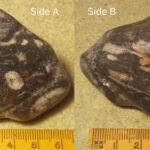




































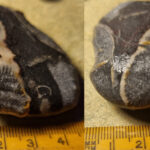
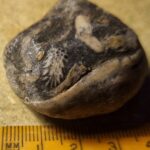












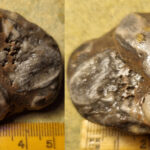




Most of these pebbles need to be wet for the shapes to stand out; and I have wet them for most pictures. I’ve used hydrochloric acid on a couple which can give more contrast; sometimes smooths the dark areas but can also make the surface features look messy. The most attractive finds have been through a lot of natural tumbling on the beach and become smooth, though of-course not as smooth as using a rock tumbler… and looking forward to trying that soon!
What are they? I’ve been learning about corals (cnidaria), the two types found in the Devonian; rugose (solitary and colonial) and tabulate, and also Bryozoans, Calcifying Algae, Stromatoporids/Sponges (porifera) etc, but its still very hard to tell things apart, obviously this will only come with experience.
The shapes are not of the animals themselves; but the skeleton or shell type structures which animals made; either solitary or colonial, then preserved and fossilised in the limestone. Sponges make a skeleton within them, individual coral polyps (animals) make exoskeletons they live inside, calcifying algae can secrete calcite structures in mats, the main Devonian reef builder stromatoporids produce fungi-like layered structures with growth rings, etc.
The common fairly large oval or circular shapes with inward pointing lines (septa) are cross sections of the solitary rugose coral mesophyllum, or seen as tubes long ways with parallel lines running from top to bottom, or in some cases actually 3-dimentional protruding from the rock.
Which means I have two types of specimens – one which has lots of 3d detail; the fossils actually standing out, and the smooth tumbled pebble types where the fossil is a flat image on the surface. These two types will require different very approaches in how to clean them up…
Devonshire Marbles – Decorative Stone
Many of the fossil pebbles are not just plain limestone but are amazingly detailed with fine branching mineral veins; strong colours of reds and oranges and dark blacks contrasting the greys of the fossils, noticing different types of limestone, and some really are works of art!
In my research I’ve been reading about the limestone quarries of South Devon; a popular all-purpose type of stone, and in the past some of the local limestone was a very sought-after decorative stone so beautiful they called it marble. This limestone has actually not had metamorphic treatment; so it isn’t actually marble from the geological perspective, but its rich and detailed landscapes of fossils and mineral veins make it very attractive when polished up.

Devonshire marbles were sourced from a few select quarries including Torquay and Ashburton etc, used in 19th century fire surrounds and marble-esque columns tiles and walls in many posh buildings etc. And I’ve realised the ‘marble’ found at certain quarries must be essentially the same stuff I’m finding in some natural pebbles on Goodrington beach.
Actual marble has been deep underground; limestone that has been heated and pressured so much that it becomes a metamorphic rock; making beautiful patterns but any fossils are gone. Our not-marble Devonian limestone has not had this treatment and has been really well preserved, and certain sections of it can be highly fossilicious rock packed with life; as well as a hard enough stone to take a shiny polish.
There are different types, or groups; of limestone found locally, some is pretty boring grey rock deposited in deeper water; other groups are literally fossilised coral reefs retaining extraordinary amounts of detail; also having 400 million years of other effects like the mineral veins; cracks and faults; colouration from mineral staining, and squeezing and stretching of the very rock itself etc.
Geological maps show Brixham Limestone (BxL), Churston, Goodrington, Meadfoot, and many other named groups; limestone formations categorised by their locations and different characteristics. The fossilicious sea defence boulders pictured above are presumably Torquay ‘marble’ or something. I’ll be trying to work out which pebbles sit in which groups based on their composition and things…
Currently reading Devonshire Marbles by Gordon Walkden which is the definitive guide to this subject.
Cleaning and polishing limestone fossil pebbles
Most of the limestone pebbles are featureless grey when dry, this is because the surface is pitted and marked with the action of being naturally knocked about on the beach, I guess the water acts like a temporary layer of varnish getting around the broken and uneven surface. I’m testing the manual sandpaper method first; which might sound like a lot of work; and it is, but the results can be very pleasing in only 30 mins or so; depending on what you are starting with.
The idea is to begin with very coarse sandpaper and then move to gradually finer sandpapers getting a level smoother each time; and eventually moving into polishing the stone for a glassy reflective wet-look; revealing all the amazing details by smoothing out the damaged surface. Here are some examples of the marble-look pebbles and initial results of hand polishing:
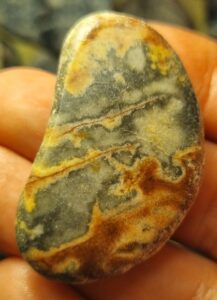





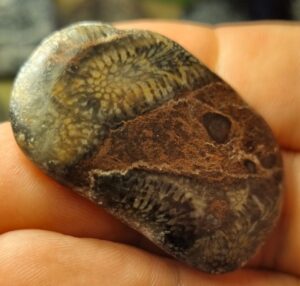






So the long term plan is now to get the kit for rock tumbling and develop a technique for making really beautiful and educational collectable finished pieces from the lucky finds on the beaches here; which I actually have only explored one fossil rich beach nearby; and I have ideas where there might be some others…
There’s an outstanding question to this story though… The sandy red Torbay Breccia which makes up the cliffs at both ends of Goodrington is Permian age red sandstone conglomerate with pebbles and other rocks embedded within. I believe these are “flash flood deposits within braided river systems” (source) which swept up many already formed Devonian limestone pebbles and locked them inside a sandstone.
If I’ve got this right… reef deposits get laid down in the Devonian approx. 400ma ago and over tens of millions of years became limestone rock, this is gradually uplifted and weathers into a river system; getting tumbled into pebbles by water, and sometime in the Permian these rounded pebbles get washed into a torrent of sandy water and settle into a sandstone about 300ma ago. This rock then stays in the ground for 300 million years; until now; when the sandstone breccia-conglomerate is exposed and erodes releasing the sand and the pebbles once again…?!

If you look at the pebbles embedded in the Permian conglomerate you’ll see many look the same as the fossilicious pebbles we find on the beach today. So the question is: have all of the fossilicious pebbles found on the beach weathered out of the Permian breccia, or is there also limestone being released from the cliffs and outcrops nearby and tumbled into pebbles more recently? Both I suspect.
The other clue I have is that I’ve found fossils at Broadsands as well now, though they are mostly different to the South Sands finds; I have found a few of the dark rice-rock type pebbles common at South Sands. I’ve even found two outcrops of highly fossilicious rock in the low cliffs to the south of Broadsands but these seam to be larger rugose corals and some beautifully preserved branching corals; still ‘in situ’ on the exposed faces of the limestone. See the Broadsands section below, research ongoing…
Triangle Point, Meadfoot
I wanted to visit Meadfoot to look for mica-schist as seen on a geological map; but I searched the west end of the beach and found none, not sure where this stuff outcrops, but I did find a lot of ‘greenstone’ which is interesting as I’ve found a few pebbles of it at Broadsands and Goodrington; a distinctive dark green rock with what I assume is olivine crystals; but I don’t know…
I had to venture over the rocks at Triangle Point to see what was the other side; and as you descend the highly angled and difficult to navigate surface if you look back at that ‘wall’ you’ll see the whole surface is littered with coral fossils! This huge article on Torquay geology tells the story: wessexcoastgeology.soton.ac.uk/Torquay.htm But basically it looks like loads of bits of branching corals all thrown together and set in stone; now naturally weathering out; 400 million years later.

Interestingly, the tilted rock face we see here is upside-down from when it was laid down; the underside of a sedimentary bed. Yes, this ancient coral reef is now upside down! This whole rock unit with its easily visible layers/beds going up the cliff is all upside down, the area was compressed; deformed; and eventually folded over the top of itself, over-turned. This crazy folding of the ground occurred in the big crunch as two continents came together, as discussed elsewhere. The limestone itself is compressed and squished and you can see that in some of the fossils, ductile transformation; like squashing plasticine.
Fossils at Broadsands?
Sure is.. if you have patience and know what you’re looking for. Not much up at the north end, but on the wet pebble beds of the south part of the beach and around the water outlet I’ve found some interesting stuff. Often red stained limestone with grey colour or calcite cream fossils, many are very weathered and are difficult to see any real detail, but occasionally a decent fossil is found.

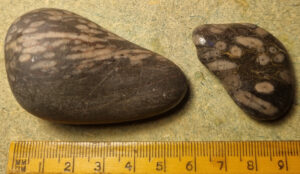
The coral sections look like they might be from the limestone south of the beach, but the rice-rock type looks more like what you’d see at Goodrington. It’s also likely that some of the fossilicious limestone is below sea level and outcrops underwater off the beach.






On the south part of the beach I came across this large chunk of red stained limestone (pic1) with a bunch of fairly large coral branches, though its hard to see detail there is some, and on the end are the cross-sections of a few to help confirm what it is (pic2). Smaller bits of this stuff with very little detail is the most common fossil I’ve found at Broadsands. Pic 4 shows cross-sections of rugose corals as well as these plant looking things which may be calcareous algae, some pretty good detail seen in these.


I can’t walk passed a rock these days and was checking all the stones used in the prom wall; mainly limestone and some red sandstone and conglomerate, but sure enough found a very interesting rock. Initial ideas are that its a rice-rock fossilicious limestone with those streams of algae type stuff; and again the shapes have been stretched; elongated; somehow… Then note the veins cutting through it vertically, and then in the middle a horizontal fracture running through that. This is a good example of ‘cross-cutting relationships’ in geology where you can work out the order of events. More thought required on this brick.
I’ve also been searching around the cliffs between Broadsands and Elberry and discovered two different spots where there are a variety of corals visible on the surface. I was blown away when I found the first piece of coral-looking stuff; with the shape very well preserved; protruding from the limestone. Looking around I realised there was more and a variety of different types, and there were some small bits I managed to release and take away. Discovery!



The cliffs are difficult to access and I’ve only looked on the tops at night, I really need a daytime mission down there for a really good look at the cliff faces and see if this is the source of the fossils found on the beach. Whist this is not a protected site; forcibly extracting any of these fossils would be vandalism, photography is the way to inspect the finds here, I’ve only taken a few tiny bits which were already lose.


I’ve been back a few times and found a large structure of fossilised reef with corals still seemingly in their natural positions, note the right-leaning trend in this pic above; zoom in and you’ll see detail, every grey shape is a fair sized solitary rugose coral! You need a keen eye to see the hidden history in these rocks; but when you look properly the stone is literally teeming with fossils.
Saltern Cove & Waterside Cove
I’ve only been here a couple of times so don’t have much to report yet; but I imagine this section will grow as I discover interesting things down there… This ‘bay’ has Saltern Cove at the north end and Waterside Cove at the south, separated by a small headland.

I visited the Waterside Cove end pictured above; accessing from Waterside caravan park; under the railway bridge and immediately left down a little lane; then rambling down the rip-rap boulders, you need to be fairly agile to do this.
The sand is red and many of the pebbles are red, limestone, mudstone; and lots of broken shell material. Also quite a few bits of granite which must have been smashed off the sea defence boulders.
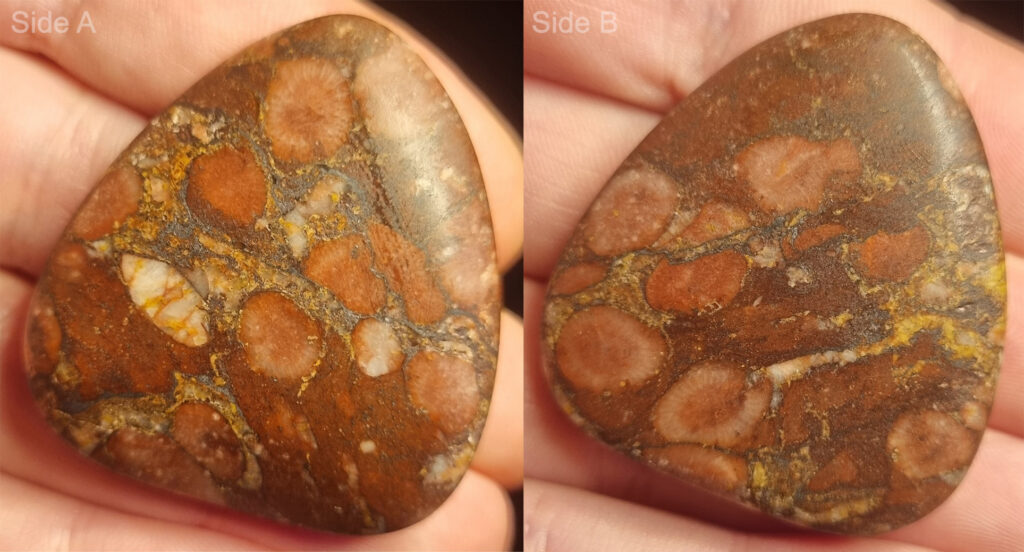
I found a few limestone pebbles with many small oval/round fossils showing radial symmetry; perhaps rugose corals; this strawberry crumble above is the reddest limestone I’ve come across and shed loads of pink powdery rock into the water and all over the sandpaper while I was cleaning it. Again some cool mineral veins but also a few crystals visible in on side A, no idea sure how to explain that as yet.
One of the pebbles also has a circular ‘thing’ with a hole in the middle, and this was also seen in a large rock buried in the sand; see below. These might be crinoids?! It’s possible I’m going to find loads of crinoidal limestone somewhere; definitely a reason to go back.

More coming . .. . .. .. .
This page is an active and evolving geological conversation with myself at the mo; with some pictures and notable information, I am not very experienced yet and may get some things wrong, but I am eager to learn. Comments are open 🙂
2 Comments
You cover so much stuff I am interested in. Polished rocks look ace. Keep up the blog!
Hey thank you 🙂 Geology and astronomy, deep time and the history of everything.. Your facebook group “Rocks, Minerals, Fossils and other UK treasures.” is a great help, highly recommended.